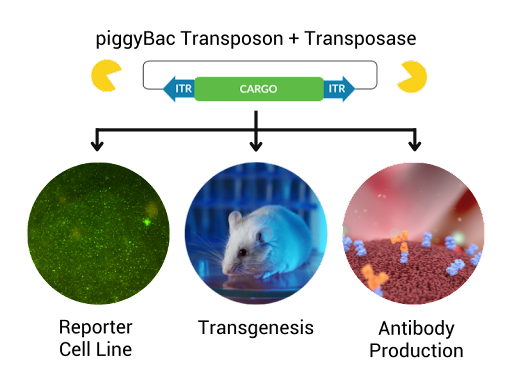For as long as genetic engineering has been possible, scientists have been searching for ways to improve upon it. One method gaining attention is known as piggyBac. The piggyBac transposon is a non-viral gene delivery and expression system which has many applications.
PiggyBac is ideal for reporter cell line creation, transgenic rodents, antibody productions and more. In this article, we will go through all of the applications and advantages of using the PiggyBac system for your next genetic engineering project.
Problems With Current Genetic Engineering Methods
One of the main problems with current genetic engineering methods is that they are based on viral vectors. Viral vectors are viruses that have been modified to carry genetic material. While they are effective at delivering genes into cells, they can also cause insertional mutagenesis, which is when the virus inserts its own DNA into the genome of the cell. This can lead to common pitfalls such as unwanted mutations and even cancer.
Another problem with current methods is that they are not very efficient. Often, only a small percentage of cells will take up the foreign DNA. This means that a lot of time and effort goes into creating transgenic animals or cell lines, only to have most of them not work.
The PiggyBac Transposon Syste
The piggyBac transposon system overcomes both of these problems. First, because it is non-viral, there is no risk of insertional mutagenesis. Second, the system is much more efficient than current methods, with up to 85% of cells taking up foreign DNA.
PiggyBac was first discovered in insects, where it is responsible for transposable element insertions into the genome. The system got its name from the fact that the transposase enzyme is derived from the Acetobacter pomorum bacteria, which are commonly known as “piggyback bacteria.”

The piggyBac transposon system consists of two parts: the transposase enzyme and the transposon itself. The transposase enzyme is responsible for cutting the DNA at a specific site, called the recognition site. The recognition site is a sequence of 18-22 base pairs that are found flanking the transposon.
The Many Applications of PiggyBac
One of the most popular applications of piggyBac is creating reporter cell lines. Reporter cell lines are cells that have been genetically engineered to express a gene of interest along with a fluorescent protein. This allows scientists to track the expression of the gene of interest in live cells.
Another popular application of piggyBac is transgenesis, which is the process of introducing new genetic material into an organism. Transgenesis is often used to create animal models of human diseases, as well as to study the effects of new genes.
PiggyBac is also frequently used for antibody production. Antibodies are proteins that bind to specific molecules and can be used to detect or remove them from a sample. They are an important tool in many different fields, including medicine and biotechnology.

PiggyBac is particularly well-suited for these three applications because it can be used to insert genes into specific locations in the genome, which is important for ensuring that the gene is expressed correctly. In addition, piggyBac can be used to insert multiple genes into the same cell, which is useful for creating cell lines or animal models that express multiple genes, reporter proteins, or antibodies.
A recent webinar described popular uses of piggyBac in ongoing research projects, and went into greater detail regarding piggyBac’s benefits and limitations. Watch it below.
Overcoming the Challenges Of Genetic Engineering
Now that we have seen some of the popular applications of piggyBac, it is clear that this transposon system has many advantages over traditional methods of genetic engineering. In addition to being more efficient and less likely to cause insertional mutagenesis, piggyBac can be used to insert genes into specific locations in the genome, which is important for ensuring that the gene is expressed correctly.
However, there are also some challenges associated with using piggyBac. One of the most significant challenges is that the transposase enzyme is derived from a bacterium, which means that it is not currently approved for use in humans. As a result, any therapies that are developed using piggyBac will need to undergo extensive safety testing before they can be used in patients.
In addition, the use of piggyBac is currently limited to research applications. However, it is possible that this technology could be adapted for use in clinical settings in the future.
Despite the challenges, piggyBac is a powerful tool that has many potential applications. As research into this technology continues, it is likely that even more uses for piggyBac will be discovered.
